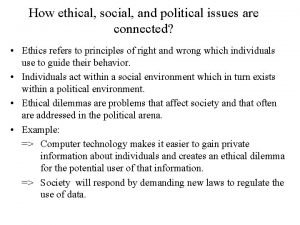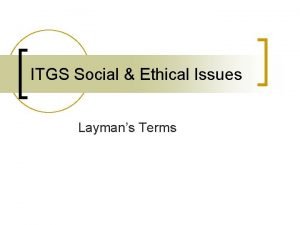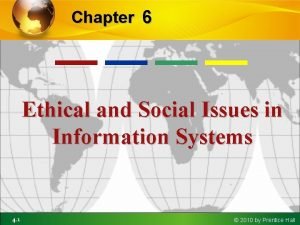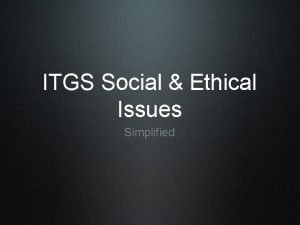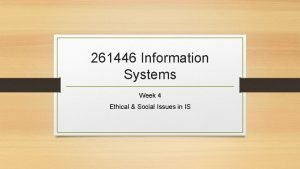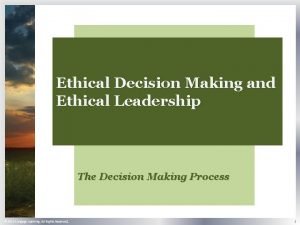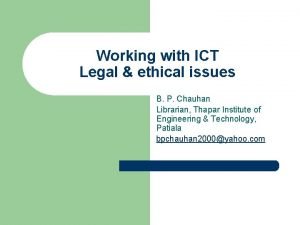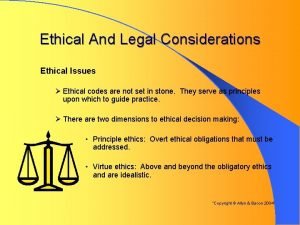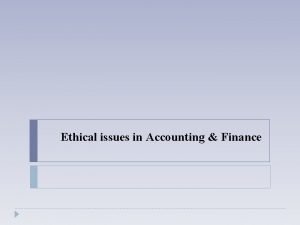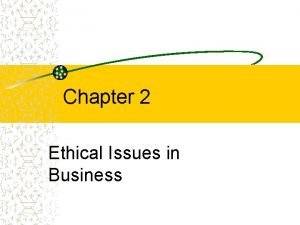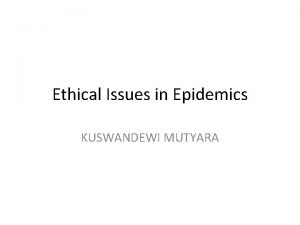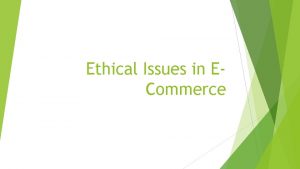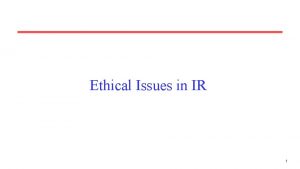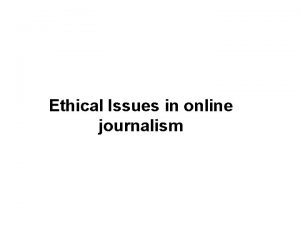How ethical social and political issues are connected
















- Slides: 16

How ethical, social, and political issues are connected? • Ethics refers to principles of right and wrong which individuals use to guide their behavior. • Individuals act within a social environment which in turn exists within a political environment. • Ethical dilemmas are problems that affect society and that often are addressed in the political arena. • Example: => Computer technology makes it easier to gain private information about individuals and creates an ethical dilemma for the potential user of that information. => Society will respond by demanding new laws to regulate the use of data.

Key technology trends which heighten ethical concerns. • The doubling of computing power every 18 months, resulting in a growing dependence on systems and a consequent vulnerability to system errors, poor data quality and failure of critical systems. • Advances in dada storage techniques and rapidly declining storage costs, resulting in the storage of a great deal of data on individuals and the routine violation of individual privacy. • Advances in data mining techniques for large databases, allowing those who are able to dominate supercomputing capacity to increase their power over individuals through the analysis of massive amounts of data about individuals. • Advances in telecommunications infrastructures, allowing the movement of massive amounts of data at greatly reduced cost, permitting the use of data and the invasion of privacy on a scale and precision unimaginable to us now.

Responsibility, accountability, and liability • Responsibility => Responsibility means that you accept the potential costs, duties, and obligations for the decisions you make. • Accountability=> Accountability is a feature of systems and social institutions that allows the determination of who is responsible. • Liability => Liability is a feature of political systems that permits individuals to recover damages done to them by responsible individuals or organizations.

Five steps in an ethical analysis • Identify and describe clearly the facts -- who did what to whom, where, when and how. • Define the conflict or dilemma and identify the higher order values involved. • Identify the stakeholders. • Identify the options you can reasonably take. • Identify the potential consequences of your options.

Six ethical principles • The Golden rule => do unto others as you would have them do unto you. • Kant’s Categorical Imperative => if an action is not right for everyone to take, then it is not right for anyone. • Descartes’ rule of change => if an action cannot be taken repeatedly, then it is not right to be taken at any time (the slippery slope rule). • The Utilitarian Principle => take the action that achieves the higher or greater value. This rule assumes you can prioritize values in a rank order. • Risk Aversion Principle => take the action that produces the least harm or the least potential cost. • No Free Lunch => virtually all tangible and intangible objects are owned by someone else unless there is a specific declaration otherwise.

Professional Codes of Conduct • When groups of people claim to be professionals, they take on special rights and obligations. • As professionals, they enter into even more constraining relationships with employers, customers and society because of the special claims to knowledge, wisdom and respect. • Personal codes of conduct are promulgated by associations of professionals in order to regulate entrance qualifications and competencies and to establish codes of ethics. • Examples of associations of professionals are: American Medical Association (AMA), American Bar Association (ABA), and Association of Computing Machinery (ACM).

Privacy and Fair Information Practices (FIP) • Privacy => Privacy is the claim of individuals to be left alone, free from surveillance or interference from other individuals or organizations, including the state. • Claims to privacy involve the workplace as well as the home. • Information technology threatens individual claims to privacy by making the invasion of privacy cheap, profitable, and effective. • Fair Information Practices (FIP) is a set of principles governing the collection and use of information about individuals. The five principles are: 1 There should be no personal record systems whose existence is secret. 2 Individuals have rights of access, inspection, review, and amendment to systems that contain information about them. 3 There must be no use of personal information for purposes other than those for which it was gathered without prior consent. 4 Managers of systems are responsible and can be held accountable and liable for the damage done by systems, for their reliability and security. 5 Governments have the rights to intervene in the information relationships among private parties.

Property Rights: Intellectual Property • Three different legal traditions that protect property rights are: • Trade secrets => An intellectual work product used for a business purpose can be classified as a trade secret provided it is not based on information in the public domain. The drawback to trade secret protection is that once an idea falls into public domain, it no linger can be protected as a trade secret. • Copyright => It is a statutory grant that protects creators of intellectual property against copying by others for any purpose for a period of 28 years. The drawback of this protection is that underlying ideas are not protected, only their manifestations in a work. • Patents => grant the owner a monopoly on the idea behind an invention for 17 years. While patent protection does not grant a monopoly on the underlying concepts and ideas, the difficulty is passing stringent criteria of non-obviousness, originality and novelty.

The most common cause of system quality problems • The most common source of business system failure is poor data quality. • Other causes are hardware failures and software bugs. • There is a technological barrier to perfect software -zero defects in software code of any complexity cannot be achieved. • Moreover, the seriousness of remaining bugs cannot be estimated. • Therefore, the potential for catastrophic failure cannot be totally eliminated.

Quality of life impacts of computers and information systems • The negative consequences can be extremely harmful to individuals, societies, and political institutions. • Computers and information technologies potentially can destroy valuable elements of our culture and society even though they bring us benefits. • Some of the negative social consequences of information systems Balancing power => The problem with highly centralized mainframe computer is that it could centralize power at corporate headquarters and in the nation’s capital. The decentralized computing and the decentralization of decision making to lower organizational levels can solve the problem. However, the problem is that the lower-level worker involvement in decision making tends to be trivial. Key policy decisions are as centralized as in the past.

Quality of life impacts of computers and information systems Reduced response time to competition => information systems have increased the efficiency of the global marketplace. As a result, business no longer can have many years to adjust to competition. Business can now be wiped out very rapidly, and along with them, jobs. Maintaining the boundaries between family, work, and leisure => portable computers and telecommuting have created the condition where people can take their work anywhere with them and do it at any time. As a result workers find their work is cutting into family time, vacations, leisure, weakening the traditional institutions of family and friends and blurring the line between public and private life.

Quality of life impacts of computers and information systems Dependence and vulnerability => business, governments, schools, and private associations such as churches are more dependent on information systems, and so they are highly vulnerable to the failure of these systems. Computer crime and abuse => computer crime is the commission of illegal acts through the use of a computer or against a computer system. Computer abuse is the commission of acts involving a computer which may not be illegal but are considered unethical. As with any other major new technology, computers have created new opportunities for committing crimes and have themselves become the target of crimes.

Quality of life impacts of computers and information systems Permanent loss of jobs => redesigning business processes could potentially cause millions of middle-level managers and clerical workers to lose their jobs. If re-engineering actually works as claimed, those workers will not find similar employment because the demand for their skills will decline. Equity and access => access to computer and information resources is not equitably distributed throughout the society. That access is distributed inequitably along social class lines (as many other resources). Poor children attending poor school districts are less likely to use computers at school. Children from wealthy homes are five times as likely to use PCs for schoolwork than poor children. Potentially we could create a society of information haves and have-nots.

Quality of life impacts of computers and information systems Health risks => business now spend $20 billion a year to compensate and treat victims of computer-related occupational diseases. Those illnesses include RSI (repetitive stress injury), CVS (computer vision syndrome) and technostress. Computer related diseases: Disease/Risk RSI Other joint diseases CVS Technostress VDT radiation Incidence 185, 000 new cases a year Unknown 10 millions cases a year 5 to 10 million cases Unknown impacts

Health Risks: RSI Repetitive stress injury => occupational disease that occurs when muscle groups are forced through repetitive actions with high-impact loads or thousand of repetitions with low-impact loads The single largest source of RSI is computer keyboard. Management actions that could reduce RSI=> • Management can reduce RSI by using workstations designed for a neutral wrist position (using a wrist rest to support the wrist) • Use of proper monitor stands and footrests will contribute to proper posture and reduce RSI. • New, ergonomically correct keyboards are also an option.

Health Risks: CVS and Technostress Computer vision syndrome (CVS)=> • refers to any eye strain condition related to computer display screen use. • Its symptoms are headaches, blurred vision, and dry and irritated eyes. The symptoms are usually temporary. Technostress=> • technostress is defined as stress induced by computer use. • Its symptoms are aggravation, hostility towards humans, impatience and enervation. • It is difficult to measure, but occupational disease claims for stress has increased dramatically as the use of computers has spread.
 How ethical social and political issues are connected
How ethical social and political issues are connected Ethical social and political issues in e-commerce
Ethical social and political issues in e-commerce Mikael ferm
Mikael ferm Legal, social, ethical and professional issues in computing
Legal, social, ethical and professional issues in computing Social ethical issues itgs
Social ethical issues itgs Ethics in mis
Ethics in mis Ethical and social issues in information system
Ethical and social issues in information system Chapter 4 ethical and social issues in information systems
Chapter 4 ethical and social issues in information systems 4 components of an information system
4 components of an information system Itgs social and ethical issues
Itgs social and ethical issues Ethical and social issues in information systems
Ethical and social issues in information systems Balanced delta delta connection
Balanced delta delta connection In a y-connected source feeding a ∆-connected load,
In a y-connected source feeding a ∆-connected load, In a ∆-connected source feeding a y-connected load
In a ∆-connected source feeding a y-connected load Ethical media issues
Ethical media issues The perceived relevance or importance of an ethical issue
The perceived relevance or importance of an ethical issue Legal and ethical issues in use of ict in education
Legal and ethical issues in use of ict in education
